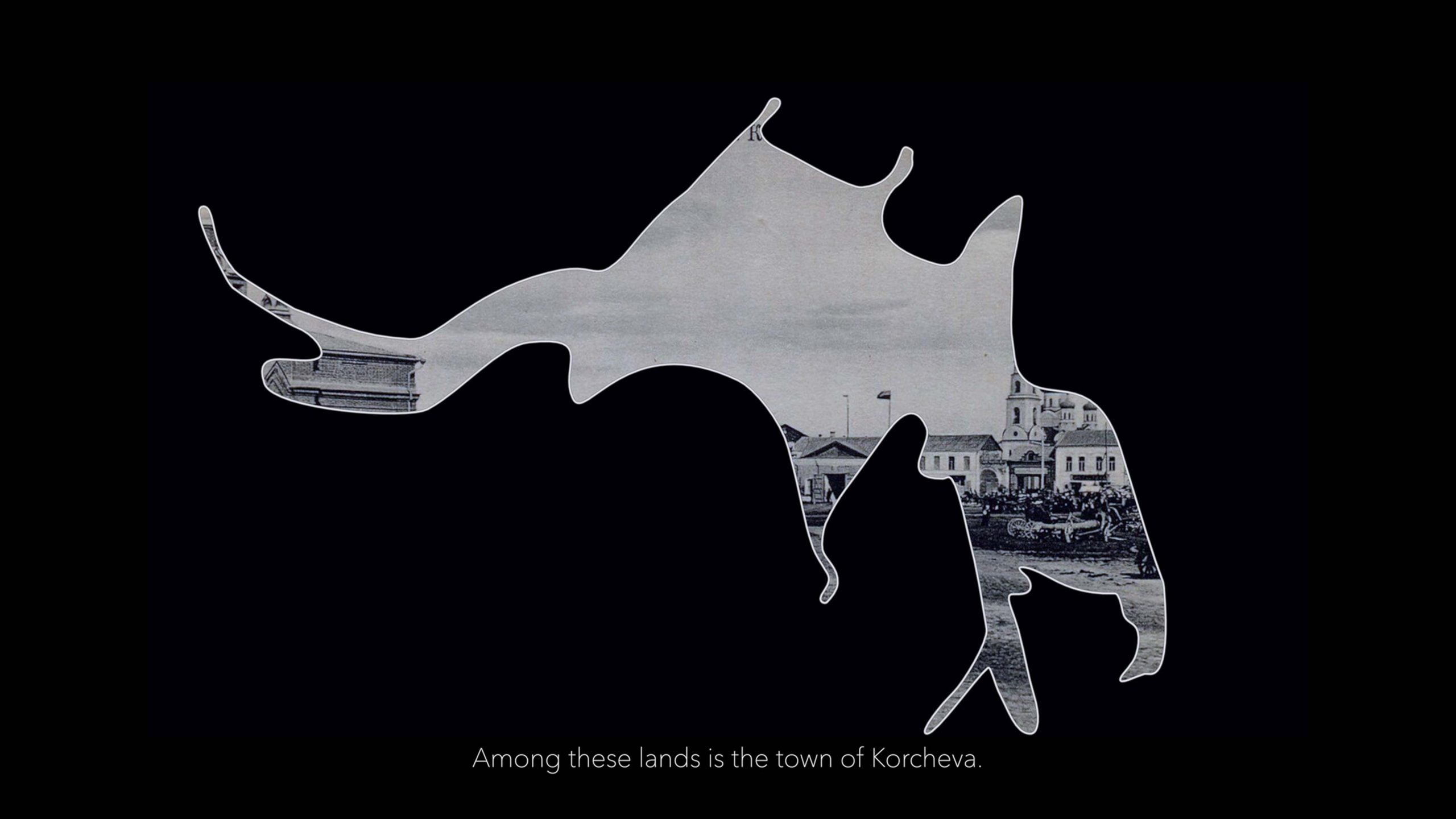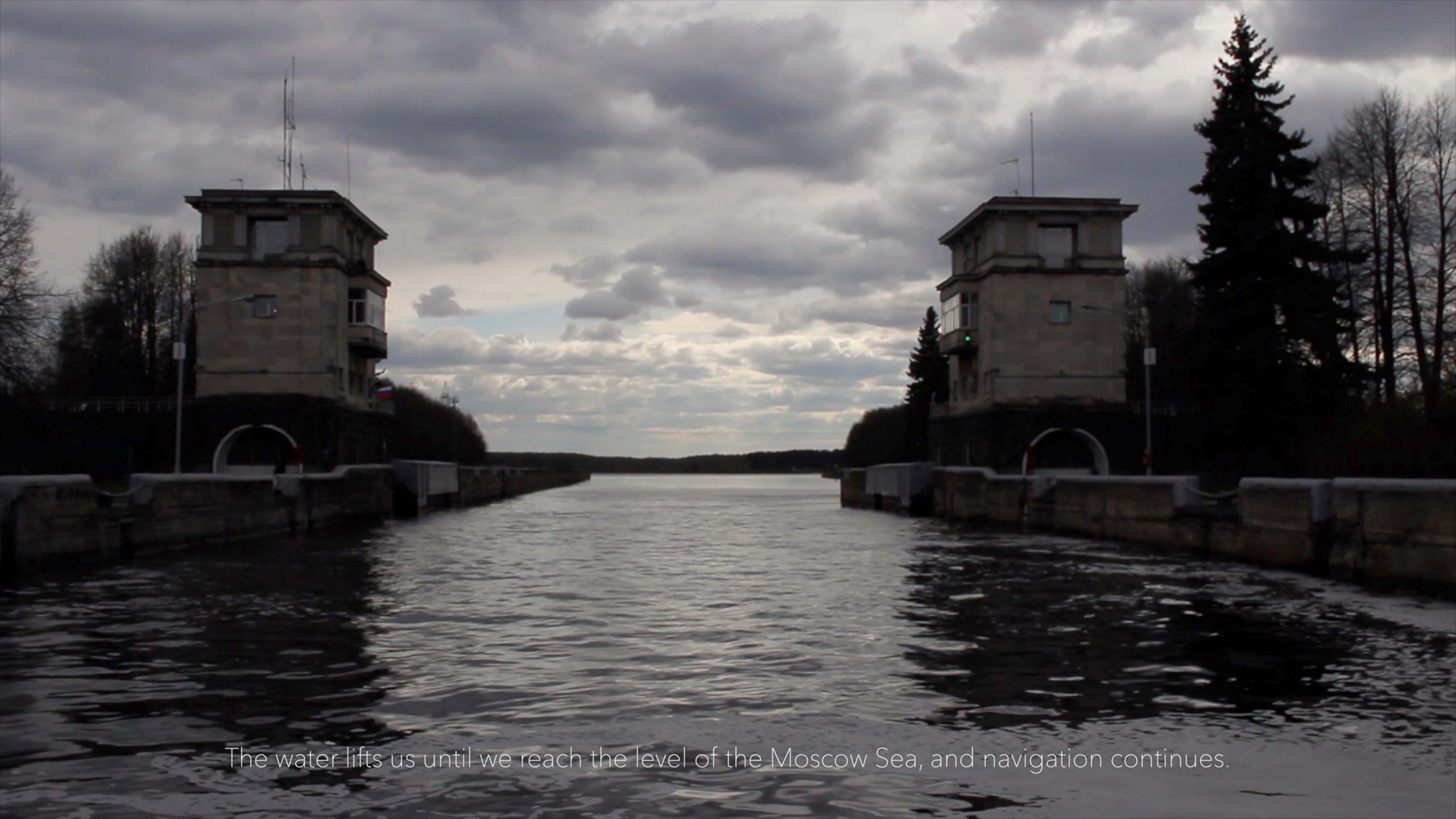A Museum Encounter with the Uglich Sea, part of Hydraulic Seas on the Volga River
A chapter of a video essay in six chapters

Hydraulic Seas on the Volga River. Chapter One, 2022. Video still. Courtesy of the artist.
Hydraulic Seas on the Volga River explores bodies of water that entangle the nature/culture divide—human-made water reservoirs. The project offers an operative concept of a hydraulic sea to engage with multiple histories of water basins that facilitate infrastructures of hydro energy production. This concept derives from infrastructure studies[i] and multidisciplinary research on the agency of water[ii] and approaches a water reservoir as a techno-scientific body central to a hydroelectric unit, unsettling prominent dam-driven imaginary.[iii]
A hydraulic sea appears on abandoned lands as a result of violent industrial invasion: rerouting of a river, flooding of a living area, or clearing of forests. An assemblage of nonhuman agents, the flow of a hydraulic sea can register and preserve records of its forceful transformations. Such records challenge congealed archival taxonomies, pointing towards their limitations, and calling for new data collection and storytelling approaches that convey histories of more-than-human worlds.
Hydraulic Seas on the Volga River looks into water reservoirs along the flow of the Volga River. Particularly, the project investigates the flooding of five towns that occupied the zone of hydropower plants: Korcheva, Kalyazin, Mologa, Puchezh Volzhskiy, and Stavropol Volzhskiy. It traces how submerged places persist in memory, underwater, and through material artefacts. It engages with objects discovered in field trips to the towns, such as sculptures, photographs, and architectural models, and offers a way to reconsider their histories and interrogate the major narrative of Soviet national world-building endeavour.

Hydraulic Seas on the Volga River. Chapter One, 2022. Video still. Courtesy of the artist.
The project intertwines research from natural, political, and social sciences[iv]. It builds on the works that examine forced labour exploitation, resource extraction and other drivers of hydropower infrastructure development in Soviet Russia. It attempts to fill voids in the archive and refute outdated assumptions by studying material residues collected on reservoirs’ shores, observed in museums, and described in publications. It analyzes aesthetic qualities, provenance, function and preservation state of found objects and recontextualizes the artifacts engaging with the histories of Soviet cultural production between the 1930s–1960s.
Hydraulic Seas on the Volga River takes the shape of a six-chapter video essay, with every chapter presenting an auto-theory fiction story about one hydraulic sea. The project lands itself between the genres of theory- and auto-fiction to invert the grand style of the explored narrative. Instead of reproducing a gaze that glorifies and monumentalizes technologized water bodies, it develops a first-person encounter with them. It suggests a form of storytelling that articulates theoretical concepts outside designated fields and immerses them in praxis. Likewise, the project contrasts gigantomanic and militarized visual language that portrays water reservoirs with alternative modes of representation.
Each chapter conflates a situated personal account of travelling to hydraulic seas, a broader history of flooded towns, and a comparative theoretical framing that addresses Soviet world-building as a modernity project. The first narration mode revolves around field notes from trips to flooded towns. The second comprises archival materials and assembles footage of water reservoirs produced in the 1930s for official documentaries and newsreels. The third articulates theoretical tools that position Soviet modernity in relation to other modernity projects. By composing a chapter of three intertwined stories, the project attempts to undo the linearity of the major national narrative and repair the silenced pasts that haunt the presents of the underwater towns.

Hydraulic Seas on the Volga River. Chapter One, 2022. Video still. Courtesy of the artist.
A Museum Encounter with the Uglich Sea, the project’s second chapter, tells a story of two encounters with the Uglich Reservoir, or the Uglich Sea: in a white-cube space of the Moscow State Architectural Museum and on a motor boat, traversing the submerged part of town. The chapter examines a recent museum installation of frescos that were preserved from the exploded temple in 1939 and a collection of photographs depicting architectural elements of the religious site before its destruction taken by an expedition of art historians, architects, and restorers. It compares two gazes of art connoisseurs—contemporary curators and expedition members—who present parts of an architectural ensemble endowed with extraordinary cultural value but also evident of people’s displacement, objects’ detachment, and discontinued relations between them.
Additional links
Trailer: https://vimeo.com/735381719
Introduction and Part One are available on request (my email address: nastia.volynova@gmail.com)
Bio
Nastia Volynova is an interdisciplinary researcher and artist whose practice revolves around writing, video essays, collective reading practices, and walking tours. Nastia explores bodies of water, archives, politics of violence, and narrative production. She is part of residues of wetness art and research collective, which develops a public digital archive of thinking with and about water’s entanglements, fluidities and discontinuities. Nastia holds a Postgraduate Diploma in Curating and an MA in Contemporary Art Theory from Goldsmiths, University of London. Her works have been presented in Amsterdam, Cambridge, Glasgow, Lisbon, London, Moscow, Rotterdam, Venice, and other places. https://www.nastiavolynova.info
[i] Matthew Curtis Hockenberry, Nicole Starosielski, and Susan Marjorie Zieger (eds.), Assembly Codes: The Logistics of Media, (Durham: Duke University Press, 2021), https://doi.org/10.1215/9781478013037.
[ii] Astrida Neimanis, Bodies of Water: Posthuman Feminist Phenomenology, (London; New York: Bloomsbury Academic, 2017), https://doi.org/10.5040/9781474275415; Jamie Linton, What Is Water? The History of a Modern Abstraction, (Vancouver: UBC Press, 2010); Philip Steinberg, “The Power of Water”, in Handbook on the Geographies of Power, Mat Coleman and John Agnew (eds.), (Northampton, MA: Edward Elgar, 2018), https://doi.org/10.4337/9781785365645.
[iii] Ashley Carse, Beyond the Big Ditch: Politics, Ecology, and Infrastructure at the Panama Canal, (Cambridge, Massachusetts: The MIT Press, 2014), https://doi.org/10.7551/mitpress/9780262028110.001.0001; Erik Swyngedouw, Liquid Power: Water and Contested Modernities in Spain, 1898-2010, (Cambridge, Massachusetts: The MIT Press, 2015); Maria Kaika, City of Flows: Modernity, Nature, and the City, (New York: Routledge, 2005), https://doi.org/10.4324/9780203826928.
[iv] For several publications, see Cynthia A. Ruder, Building Stalinism: The Moscow Canal and the Creation of Soviet Space (London: I. B. Tauris, 2018), https://doi.org/10.5040/9781350985612, Evgeny Burdin, Volzhskiy kaskad GES: Triumf i tragedia Rosii (Moscow: ROSSPEN, 2011), Ivan A. Lifanov, Organizatsia chashi vodokhranilischa, (Moscow, Leningrad: Gosudarstvennoe energeticheskoe izdatelstvo, 1946), Oleg Khlevniuk, The History of the Gulag: From Collectivization to the Great Terror (New Haven, CT: Yale University Press, 2004), and R. W. Davies, “The Industrial Economy in the Mid-1920s” and “The Triumph of Rapid Industrialisation”, in The Industrialization of Soviet Russia 3: The Soviet Economy in Turmoil 1929-1930, (London: Palgrave Macmillan, 1998), 1–94, https://doi.org/10.1007/978-1-349-14942-1.




